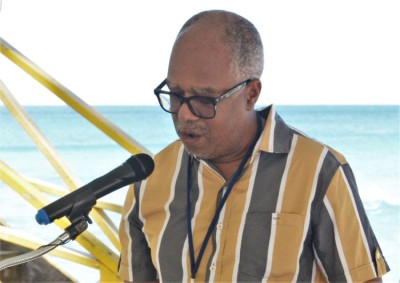Water Level Sensors Help Barbados Detect Impending Tsunamis
BRIDGETOWN, Barbados – Barbados has the capacity to detect, and receive early notice of, an impending tsunami event to assist with the timely evacuation of coastal areas under threat.
 Deputy Director of the Barbados Meteorological Services, Brian MurrayDeputy Director of the Barbados Meteorological Services (BMS), Brian Murray said on Wednesday that water level sensors which sense pronounced changes in the level of the ocean are placed at strategic locations across the island.
Deputy Director of the Barbados Meteorological Services, Brian MurrayDeputy Director of the Barbados Meteorological Services (BMS), Brian Murray said on Wednesday that water level sensors which sense pronounced changes in the level of the ocean are placed at strategic locations across the island.
“This equipment is very critical,” he said, adding that the BMS’ early warning systems for tsunamis and other hydrometeorological hazards include alerts from the Pacific Tsunami Warning Centre; The University of the West Indies Seismic Research Centre; the BMS Insight app and the CAP.CAP app.
In addition, the Deputy Director said the BMS was in the process of refining its Multi-Hazard Early Warning Systems (MHEWS) to allow for earlier warning in the event of a hazard impact. These early warning systems include equipment such as the Doppler radar, automatic weather stations, satellite imagery and numerical weather models.
Murray cautioned that the threat of a tsunami, generated by undersea earthquakes in the Eastern Caribbean or in the Atlantic Ocean, could not be ignored.
Barbados was affected by tsunamis in 1755 and 1761 from earthquakes in Lisbon, Portugal; in 1767 from an earthquake in Martinique; in 1902 from a volcanic eruption from La Soufriere Volcano in St. Vincent and the Grenadines; in 1939 from a sub-marine volcanic eruption of Kick ’em Jenny, and in 1969 from an earthquake in Guadeloupe.
On those occasions, tsunami wave run-ups ranged from 0.4 meters to 1.8 meters, which were categorized as “relatively minor”.
However, Coastal Planner at the Coastal Zone Management Unit (CZMU), Fabian Hinds, gave the assurance that Government, in collaboration with its strategic partners, was working towards improving Barbados’ resilience to coastal hazards.
He noted that there are plans by the CZMU and the Department of Emergency Management, who co-chairs the Technical Standing Committee on Coastal Hazards (TSCCH), to implement the Tsunami Ready Recognition Program in Barbados.
“This ultimately seeks to develop and enhance the preparedness and response capabilities of coastal communities to the potential threat of tsunamis,” he said.
In 2020, two communities in the northern parishes of St. Lucy and St. Peter received official Tsunami Ready recognition status. Efforts are now under way to achieve the recognition for coastal areas in the west and south of the country.
“The intention is to work towards making all of Barbados’ coastlines tsunami ready,” Hinds said.


